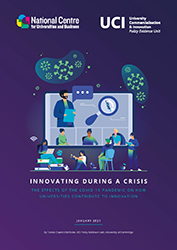
As COVID-19 has taken its devastating toll, we have all been witness to astonishing examples of university-industry collaboration in driving innovation. However, while innovation has flourished in a few areas of the economy, many sectors are struggling to sustain their R&D and innovation activities at pre-pandemic levels. This will have long-term consequences for our national recovery and resilience.
Innovation will be required across the breadth and depth of our economy and country if we are to rebuild at pace and address the long-standing economic imbalances holding back the UK. A robust system of universities, research institutes and technology development organisations, working in close partnership with the private and public sectors will have a critical role to play in making that happen. However, while there is an increasing body of evidence to show how COVID-19 is adversely affecting R&D and innovation activities in key sectors, there has been less clarity about its effect on universities and their ability to contribute to innovation through the crisis, the economic recovery and beyond.
 Which is why UKRI asked my team (the new University Commercialisation and Innovation Policy Evidence Unit at the University of Cambridge) and the National Centre for Universities and Business to find out what has been happening to UK universities and their industrial collaborations. Through August-September 2020, we surveyed senior UK university leaders with responsibilities for innovation-focused activities and partnerships in 61 institutions.
Which is why UKRI asked my team (the new University Commercialisation and Innovation Policy Evidence Unit at the University of Cambridge) and the National Centre for Universities and Business to find out what has been happening to UK universities and their industrial collaborations. Through August-September 2020, we surveyed senior UK university leaders with responsibilities for innovation-focused activities and partnerships in 61 institutions.
What did we find? A mixed picture, with just under half of the universities experiencing a decline in their innovation-related activities. For one in six, those declines amounted to more than 20 per cent decreases in their activity levels. A further third saw little change, while around two in ten experienced increases. However, what these aggregate results disguise is the significant variation in how the pandemic has affected universities’ engagement with different sectors of the economy.
Some sectors are faring better than others
Across the board, many universities have experienced quite dramatic declines in their activities with sectors such as aerospace and automotive manufacturing, the creative industries, and with non-biomedical R&D, scientific and technical services. By contrast, activities with the pharmaceutical industry and with human health and social work services have been much less affected.
At the time of the survey at least, projects were not necessarily being cancelled altogether. Rather, deadlines were being extended, planned projects delayed, and the scale and scope of projects reduced or refocused on shorter term partner priorities. Some partners were also looking to renegotiate financial and other contractual terms. Overall the picture is one of trying to preserve projects – and hence relationships – as much as possible. This begs the question: for how long is this a sustainable approach?
The importance of strategic partnerships
In this context, the survey highlighted the value of long-term strategic partnerships between universities and their industrial partners. Strategic partnerships focus on developing win-win opportunities for each partner by aligning their strategic interests, building strong strategic and technical-level relationships and by taking steps to reduce the transaction costs of interactions. These kinds of partnerships have proved much more resilient than those focusing on shorter-term interactions, more narrowly defined projects, with activity much less affected and, indeed, increasing in almost four in ten universities. Both universities and companies in these types of collaboration were more likely to invest time and energy in finding ways to sustain them through the crisis.
Necessity is the mother of invention: new ways of working
We also investigated the impact of the pandemic on how universities work with their industrial partners. In spite of severe national restrictions to combat the spread of the virus, university and industry teams found ways of coming together to fast-track new projects to address COVID-related challenges, such as developing vaccines and treatments, manufacturing ventilators and co-ordinating the supply of PPE. The urgency of the situation, a collective vision, and a good amount of trust enabled them to agree objectives and broad terms of engagement at speed and start work while the finer legal details were ironed out – an approach that would not have been possible pre-pandemic.
As buildings were shuttered and staff switched to remote working, universities also found ways of sustaining a broad range of non-COVID related activities. Those responding to the survey highlighted new practices that could help to improve the effectiveness and value of their innovation engagements beyond the pandemic. For example, the move online increased the effectiveness of certain activities, such as some types of workshop. It made some activities more accessible, for example to senior executives with very limited bandwidth, and it enabled productive interactions with partners much further afield than previously. Indeed, as university staff became more adept with online collaboration tools and no longer relied on periodic face-to-face meetings to drive relationships, some partners found that the quality of their interactions improved.
Driving innovation: a greater role for universities
We also explored how universities may shift their strategic priorities to help drive the post-pandemic economic recovery. Strengthening research portfolios remains a core preoccupation for university leaders. However, it is clear from the survey that a number of other priorities are emerging alongside it.
University leaders see a growing need for more challenge-led programmes that more closely integrate research with its translation and commercialisation into applications. They also envisage taking a more active and important role in supporting partners in the later stages of the innovation process and in adopting new technologies and processes to drive efficiency and productivity improvements. Finally, the survey respondents see an increasingly important and strategic role for universities in investing to strengthen the enabling conditions of the local and sectoral systems within which innovation takes place.
What next?
As we move beyond the pandemic, nations are facing difficult decisions about where and how to invest in order to drive an economic recovery. Core funding for research must be protected. It is this knowledge base, built up over many decades, which enables universities to make breakthrough advances and develop technical solutions to a wide range of innovation challenges.
However, this is not sufficient in itself. Universities were able to respond so rapidly to the health crisis because they had not only the necessary technical expertise, but they also had a mature knowledge exchange support system which enabled them to work productively with industrial partners, investors and others to further develop their ideas and inventions into real-world applications.
It is here that the university leaders who responded to our survey are calling for more action. They would like to see more funding for challenge-driven programmes; greater and more coherent support for the translation and commercialisation of ideas and inventions; and to sustain the funding that allows universities to nurture their innovation partnerships, commercialisation and wider knowledge exchange activities.
COVID-19 has shown what university-industry partnerships can do under pressure. Now is the moment to build on that experience and put in place the mechanisms that will enable them to drive an innovation-led national recovery. We can and must do more.

Tomas Ulrichsen,
Director, UCI Policy Evidence Unit, University of Cambridge
March 2021
